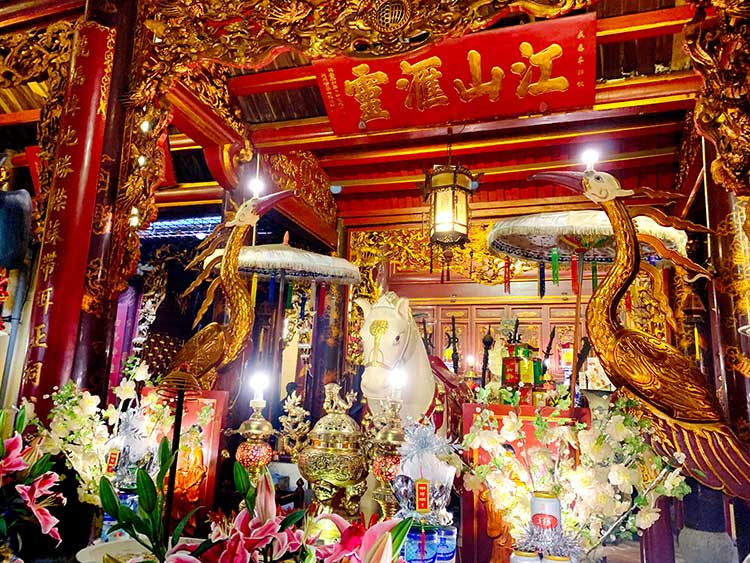Located in the heart of Hanoi’s Old Quarter, Bach Ma Temple is a remarkable historical monument that holds great significance in the city’s rich cultural heritage. As the oldest temple in Hanoi, Bach Ma Temple boasts a fascinating history that dates back centuries, intertwined with legends and tales of ancient gods and kings. In this comprehensive guide, we will delve into the captivating story behind Bach Ma Temple, explore its architectural highlights, and provide practical information for visiting this sacred site.
I. The History of Bach Ma Temple
Bach Ma Temple, also known as the ‘White Horse Temple,’ was originally built in the 9th century and is believed to be dedicated to Long Do, the ancient god of Hanoi. According to legend, the temple played a crucial role in King Ly Thai To’s decision to relocate the capital from Hoa Lu to Thang Long (now Hanoi) in 1010 AD.
Historical records recount that King Ly Thai To faced numerous challenges in constructing the new citadel. However, his fortunes changed when a white horse emerged from the temple, leaving marks on the ground as it wandered. Taking this as a divine sign, the king ordered the construction of the citadel walls along the path marked by the horse, which eventually led to the successful completion of the capital. In honor of this auspicious event, the temple was renamed Bach Ma, meaning “white horse.”
II. The Architecture of Bach Ma Temple
Bach Ma Temple showcases a unique architectural style that reflects the influence of the Nguyen Dynasty. The temple’s layout is designed in the shape of the Chinese character “Three,” and its exterior resembles an 8-roof communal village house adorned with intricate ancient patterns reminiscent of Hoi An’s fine arts.
The temple’s interior is equally captivating, featuring well-carved pillars and wooden beams that exude a sense of nostalgic grandeur. One notable architectural element is the unorthodox tie-beam composition made of ironwood, which not only serves as a decorative art form but also provides structural support to the temple. Visitors will also marvel at the numerous altars adorned with exquisite engravings and a collection of valuable antiques, including paintings, imperial titles, ancient weapons, stone stelae, metal bells, and palanquins.
III. Exploring Bach Ma Temple
Visiting Bach Ma Temple offers a unique opportunity to appreciate the ancient artistry of engraving and immerse oneself in the serene ambiance of this sacred place. While the temple is open to visitors throughout the year, the most enchanting time to experience Bach Ma Temple is during its annual traditional celebration, which takes place from February 12th to February 13th according to the Lunar Calendar.
During this celebration, a procession of palanquin bearers, unicorn dancers, drummers, and flag bearers winds its way from Ma May Street back to Bach Ma Temple. The highlight of the ceremony is the rite of sacrifice, a significant part of the festivities that is performed with utmost solemnity. After the main acts are completed, visitors are welcome to enter the temple and participate in various cultural activities and Vietnamese folk games, such as tug of war, cock-fighting, human chess, and festival song competitions.
IV. How to Get to Bach Ma Temple
Bach Ma Temple is conveniently located in the heart of Hanoi’s Old Quarter, although the city’s narrow and crowded streets can make finding the way a bit challenging. To reach the temple, follow the typical route starting from Nguyen Thai Hoc Street, passing through Cua Nam Street, Phung Hung Street, and Hang Vai Street until reaching Hang Buom Street, where the temple is situated at No.76.
Transportation within Hanoi can be easily managed by choosing the right means of transport. Traveling by motorbike or car typically takes around 30 minutes, depending on the traffic conditions. Buses are a suitable option for larger groups, with buses numbered 18 or 32 stopping at Tran Nhat Duat station, a mere 500 meters away from Bach Ma Temple. For a more leisurely experience, consider taking a pedicab, where the riders possess an intimate knowledge of the city’s streets.
V. Additional Tips for Visiting Bach Ma Temple
To ensure a pleasant visit to Bach Ma Temple, keep a few practical tips in mind:
- Be mindful of pickpockets, especially during the temple’s annual celebration when the crowds are larger.
- Respect the rules and religious beliefs associated with the temple’s worshiping ceremonies. Dress modestly and avoid touching or speaking loudly within the temple grounds.
- Take advantage of your visit to the Old Quarter by exploring nearby attractions such as Hoan Kiem Lake and the Grand Opera House. Indulge your taste buds in local delicacies like Trang Tien Ice Cream, steamed rice pancakes (“banh cuon”), and noodles with grilled meat (“bun cha”).
Bach Ma Temple stands as a testament to Hanoi’s rich history and cultural heritage. With its fascinating legends, stunning architecture, and annual traditional celebrations, this ancient temple offers visitors a glimpse into the past and a chance to immerse themselves in Vietnam’s vibrant traditions. As you embark on your journey to Hanoi, make sure to include Bach Ma Temple on your itinerary for an unforgettable experience steeped in history and spirituality.


